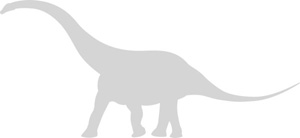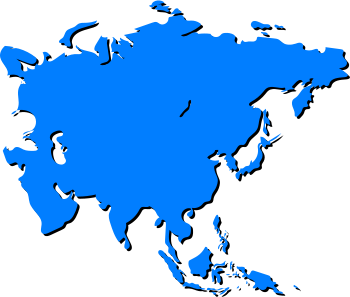Every month, 100,000 readers use the Dinosaur Database, but we receive no support from you. Developing and updating the database requires a lot of work. If you want it to remain open and be updated, please support us via the "Buy us a coffee" button available on every page or via the Support page.
Dinosaur: Wudingloong wui

| Length*: | 4.9 m | 16.1 ft |
| Weight*: | 400 kg | 882 lb |
*The largest known specimen
Period
Epoch: Early Jurassic
Stage: Hettangian-Sinemurian
Years: 201.4–190.8 Ma
Details
Status: valid
Author: Wang et al.
Year: 2025
Distribution
Description
Wudingloong wui
Wudingloong wui is a basal sauropodomorph dinosaur from the Early Jurassic of Yunnan Province, China. The holotype specimen was discovered in the Yubacun Formation, which is the lowest dinosaur bone bed in East Asia, dated to the Hettangian to early Sinemurian (~200.17 million years ago). This new taxon was formally described by Ya-Ming Wang, Qian-Nan Zhang, Yan-Chao Wang, Huan Xu, Jianbo Chen, Zhuo Feng, Xing Xu, Tao Wang, and Hai-Lu You.
Wudingloong wui represents the earliest-diverging and stratigraphically oldest sauropodomorph dinosaur discovered in East Asia to date. Its discovery provides crucial insights into the early evolution of postcranial morphology and body size within the sauropodomorph clade, and further highlights the taxonomic and morphological diversity of the sauropodomorph assemblage in southwestern China.
The genus name “Wudingloong” combines “Wuding” (referring to Wuding County, where the discovery was made) with “loong” (the Mandarin word for “dragon”). The species name “wui” honors Dr. Xiao-Chun Wu of the Canadian Museum of Nature, acknowledging his significant contributions to Chinese paleontology.
Geographic Coordinates
- Continent: Asia
- Country: China
- Region: Wuding County, Yunnan Province
- Locality: Wande Town
- Formation: Yubacun Formation
Physical Characteristics
The holotype specimen, designated LFGT-YW002, is reposited at the Lufeng Dinosaur Fossil Group Museum. It comprises a well-preserved partial skeleton, including a skull and mandible, along with numerous postcranial elements.
Fossil material recovered includes:
- Anterior and posterior cervical vertebrae.
- Dorsal vertebrae (including two articulated with the sacrum).
- Three sacral vertebrae.
- Middle and posterior series of caudal vertebrae.
- Right scapula and coracoid.
- Right forelimb, including the humerus, ulna, radius, and manus (hand elements, particularly a large and robust ungual of manual digit I).
- Left ilium and partial ischium.
- Left hindlimb, including the femur, tibia, fibula, astragalus, and various pedal elements (foot elements).
Key Diagnostic Features (distinguishing Wudingloong wui from other non-sauropodiform sauropodomorphs):
- An ascending ramus of the maxilla (upper jaw bone) excavated by a distinct triangular antorbital fossa.
- A prominent ventral keel (ridge) present on the middle cervical centra (main body of the neck vertebrae).
- A slender humerus (upper arm bone) with a flat and low humeral head.
- A gracile (slender) metacarpal V (fifth hand bone) whose proximal end is as wide as its distal end.
- A notably large and robust ungual (claw) on manual digit I.
Other notable anatomical features described:
- Absence of Pneumaticity: Significantly, pneumatic foramina or fossae (indicating air sacs) are explicitly absent in all the dorsal vertebrae. This suggests that extensive postcranial skeletal pneumaticity (PSP), a common feature in later sauropods, was not present in Wudingloong.
- The scapula (shoulder blade) is relatively gracile, with its minimum blade width being about 0.16 times its total length.
- The humerus, when viewed anteriorly or posteriorly, shows a low and only slightly convex proximally oriented humeral head. The minimum width of the humeral shaft is 0.12 times its total length.
- The manus (hand) possesses a large and robust ungual of manual digit I.
Significance and Notable Facts
- Earliest East Asian Sauropodomorph: Wudingloong wui represents the earliest-diverging and stratigraphically oldest sauropodomorph dinosaur discovered so far in East Asia, providing a crucial data point for early sauropodomorph evolution in this region.
- Insights into Evolution of Pneumaticity: Its apneumatic condition (lack of air sacs in dorsal vertebrae) offers significant insights, suggesting that the acquisition of extensive postcranial skeletal pneumaticity was not a universal feature among early Massopoda. This challenges previous assumptions about the early evolution of this key sauropod feature.
- Contribution to Southwestern China Fauna: Its discovery further demonstrates that the sauropodomorph assemblage in southwestern China is among the most taxonomically and morphologically diverse, highlighting the region as a significant hotspot for early dinosaur evolution.
- Understanding Early Sauropodomorph Morphology: The well-preserved partial skeleton, including the skull and postcranial elements, provides a comprehensive view of the anatomy of an early sauropodomorph, aiding in clarifying the evolutionary steps in body plan development.
Conclusion
Wudingloong wui is a pivotal discovery for understanding the early evolution of sauropodomorphs. As the earliest-diverging and stratigraphically oldest sauropodomorph from East Asia, it offers unique insights into the clade’s origins and diversification. Its specific anatomical features, particularly the absence of vertebral pneumaticity, provide critical data points for tracing the acquisition of key sauropod characteristics. This taxon stands as a cornerstone for future research on early sauropodomorph morphology, phylogeny, and the broader paleoecology of Early Jurassic terrestrial ecosystems.
Locations
Sources
Material: Partial postcranial skeleton, including dorsal and caudal vertebrae, scapula, humerus, radius, ulna, ilium, femur, tibia, fibula
References: Wang, Y.-M.; Zhang, Q.-N.; Wang, Y.-C.; Xu, H.; Chen, J.; Feng, Z.; Xu, X.; Wang, T.; You, H.-L. (2025). "A new Early Jurassic dinosaur represents the earliest-diverging and oldest sauropodomorph of East Asia"



